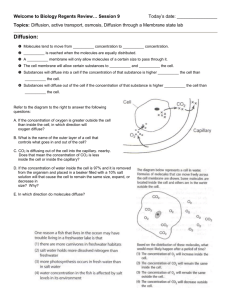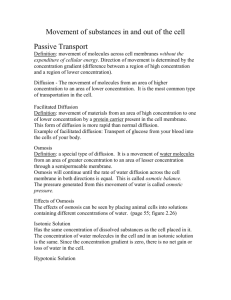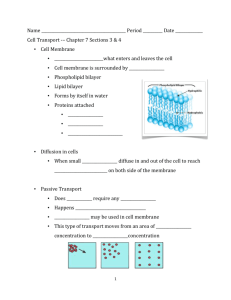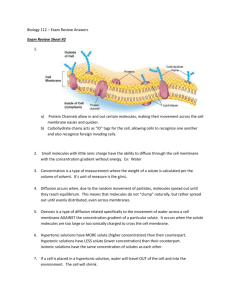Diffusion Worksheet
advertisement
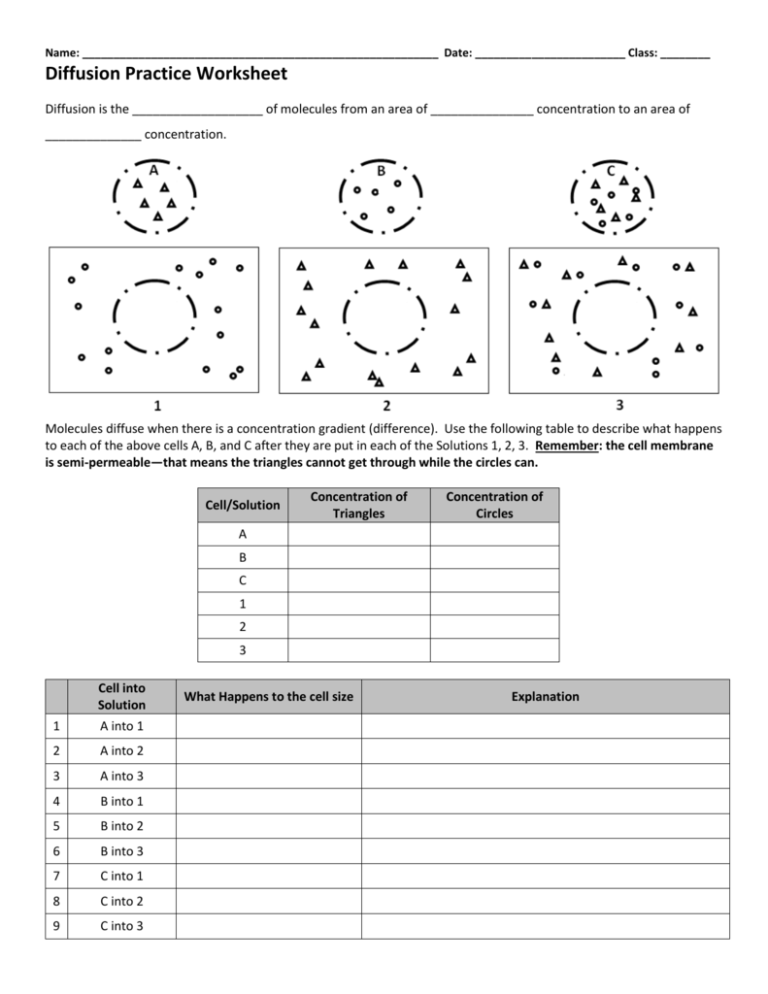
Name: _________________________________________________________ Date: ________________________ Class: ________ Diffusion Practice Worksheet Diffusion is the ___________________ of molecules from an area of _______________ concentration to an area of ______________ concentration. Molecules diffuse when there is a concentration gradient (difference). Use the following table to describe what happens to each of the above cells A, B, and C after they are put in each of the Solutions 1, 2, 3. Remember: the cell membrane is semi-permeable—that means the triangles cannot get through while the circles can. Cell/Solution Concentration of Triangles Concentration of Circles A B C 1 2 3 Cell into Solution 1 A into 1 2 A into 2 3 A into 3 4 B into 1 5 B into 2 6 B into 3 7 C into 1 8 C into 2 9 C into 3 What Happens to the cell size Explanation Name: _________________________________________________________ Date: ________________________ Class: ________ Directions: 1. Cut and paste the cells pictured in section A into each of the solutions in section B. 2. Draw an arrow using a color pencil to show the direction in which molecules will diffuse across the membrane. 3. Cut and paste your final copy into your journal under the title “Diffusion of Molecules.” Section A Section B Name: _________________________________________________________ Date: ________________________ Class: ________ Cell Membrane Movement Worksheet Directions: Complete the table comparing the types of movement across a membrane. Facilitated Passive Transport Diffusion Diffusion Uses energy? Y or N Types of Molecules Movement through phospholipid bilayer? Y or N Uses transport proteins? Y or N Direction: In, Out, Both Concentration Gradient? Down or Against Words to help you remember Osmosis Active Transport Endocytosis Exocytosis Name: _________________________________________________________ Date: ________________________ Class: ________ Diffusion Practice Worksheet Diffusion is the movement of molecules from an area of higher concentration to an area of lower concentration. Molecules diffuse when there is a concentration gradient (difference). Use the following table to describe what happens to each of the above cells A, B, and C after they are put in each of the Solutions 1, 2, 3. Remember: the cell membrane is semi-permeable—that means the triangles cannot get through while the circles can. A Concentration of Triangles 5 Concentration of Circles 0 B 0 5 C 5 5 1 0 15 2 16 0 3 10 10 Cell/Solution Cell into Solution What Happens to the cell size Explanation 1 A into 1 Cell gets bigger Circles diffuse into cell because its concentration is higher outside the cell. 2 A into 2 Cell is unchanged Triangles cannot pass across the membrane. 3 A into 3 Cell gets bigger Circles diffuse into cell because its concentration is higher outside the cell. 4 B into 1 Cell gets bigger Circles diffuse into cell because its concentration is higher outside the cell. 5 B into 2 Cell gets smaller Circles diffuse out of cell because its concentration is lower outside the cell. 6 B into 3 Cell gets bigger Circles diffuse into cell because its concentration is higher outside the cell. 7 C into 1 Cell gets bigger Circles diffuse into cell because its concentration is higher outside the cell. 8 C into 2 Cell gets smaller Circles diffuse out of cell because its concentration is lower outside the cell. 9 C into 3 Cell gets bigger Circles diffuse into cell because its concentration is higher outside the cell. Directions: Name: _________________________________________________________ Date: ________________________ Class: ________ 4. Cut and paste the cells pictured in section A into each of the solutions in section B. 5. Draw an arrow using a color pencil to show the direction in which molecules will diffuse across the membrane. 6. Cut and paste your final copy into your journal under the title “Diffusion of Molecules.” Name: _________________________________________________________ Date: ________________________ Class: ________ Cell Membrane Movement Worksheet Directions: Complete the table comparing the types of movement across a membrane. Facilitated Passive Transport Diffusion Diffusion Osmosis Active Transport Endocytosis Exocytosis Uses energy? N N Y and N N Y Y Y SMALL, UNCHARGED MOLECULES LARGER MOLECULES NEEDING HELP GETTING ACROSS WATER LARGER, CAN BE CHARGED FOOD WASTE PRODUCTS OF CELL Y Y Y Y N N N N Y N N N BOTH BOTH BOTH BOTH BOTH IN OUT DOWN DOWN DOWN DOWN AGAINST AGAINST AGAINST Proteins help Water moves Y or N Types of Molecules Movement through phospholipid bilayer? Y or N Uses transport proteins? Y or N Direction: In, Out, Both Concentration Gradient? Down or Against Words to help you remember When you are passive no energy is required Molecules move Action needs energy Endo- means “in” Exo – means “out”

